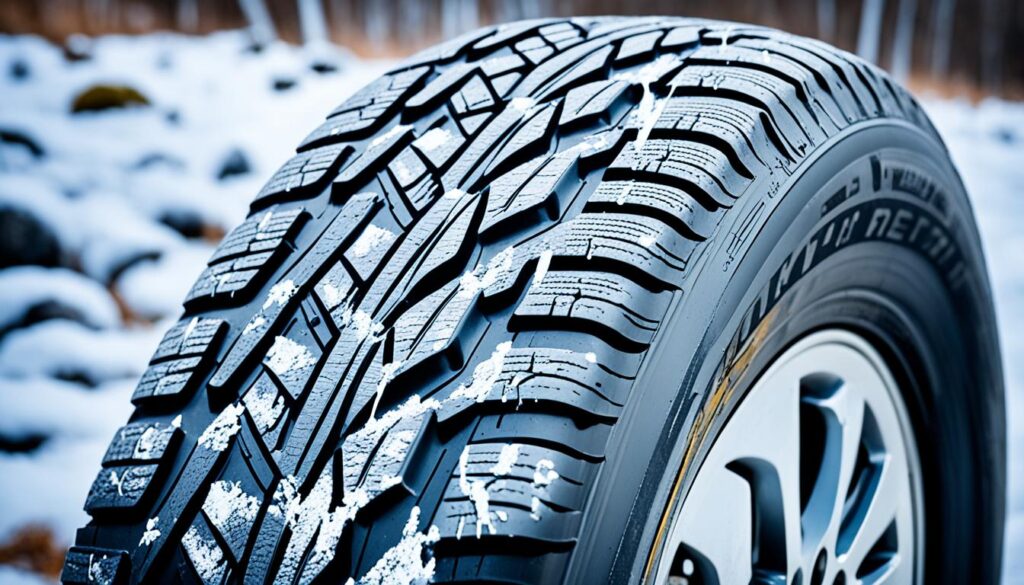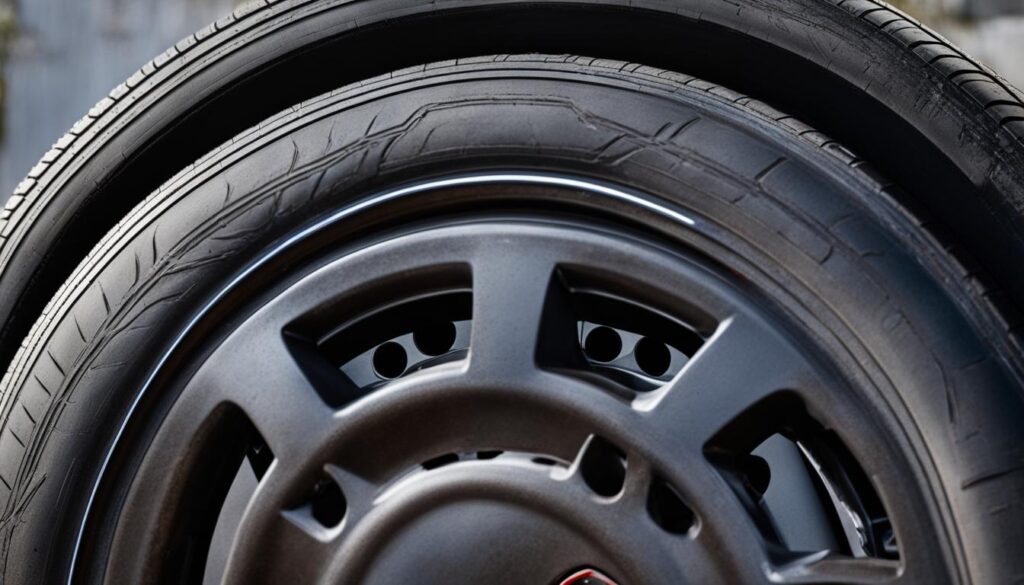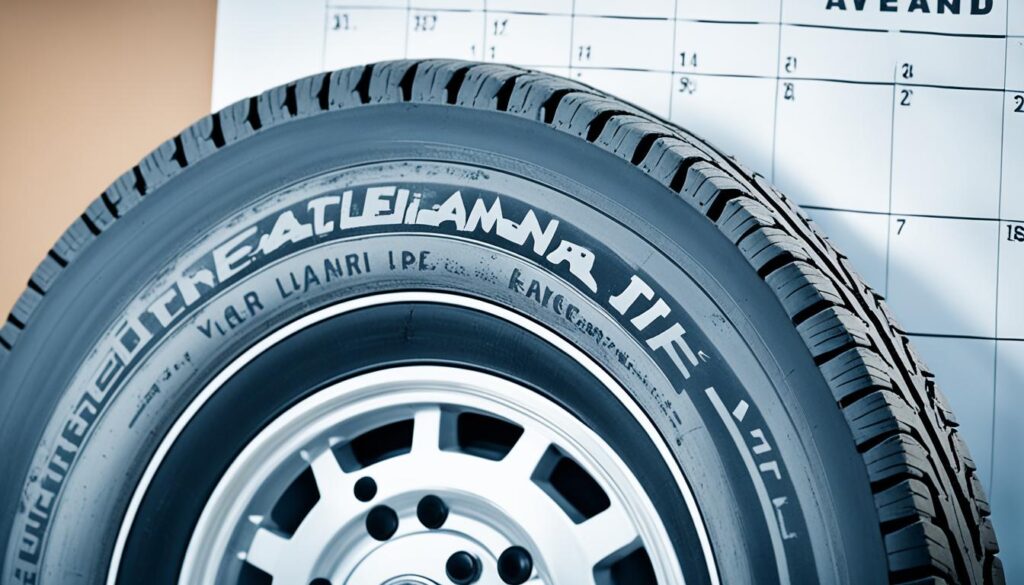Are you wondering how long your RV tires will last? Whether you’re planning a cross-country road trip or enjoying weekend getaways, understanding the lifespan of your camper tires is crucial for a safe and enjoyable journey. So, how long do RV tires really last?
RV tires typically have a lifespan of 4 to 6 years, but various factors can influence their longevity. The size of the tire, the amount of mileage, and proper maintenance all play a role in determining how long your tires will hold up. But is that all there is to it?
In this article, I will delve deeper into the average lifespan of RV tires and explore the factors that can affect their longevity. We will also discuss essential tips for extending the life of your tires and knowing when it’s time for a replacement. So, let’s embark on this journey into the world of RV tires.
Key Takeaways:
- The average lifespan of RV tires is around 4 to 6 years.
- Tire size, mileage, and maintenance affect the longevity of RV tires.
- Proper tire care, such as regular inspections and proper inflation, can extend the life of your tires.
- Understanding the signs of worn-out tires is crucial for knowing when it is time to replace them.
- Following best practices for tire maintenance and safety measures can ensure the durability and safety of your RV tires.
Contents
Factors Affecting the Longevity of RV Tires
When it comes to the lifespan of your RV tires, there are various factors to consider. Proper maintenance, regular inspections, and addressing signs of wear are all crucial for prolonging the life of your tires.
One of the key factors affecting the longevity of RV tires is proper tire maintenance. Regularly checking the tire pressure is essential to prevent excessive wear. When the pressure is too low or too high, it can result in uneven tread wear, compromising the tire’s performance and lifespan. By ensuring that the tire pressure is within the recommended range, you can significantly extend the life of your RV tires.
Regular inspections are another important aspect of tire maintenance. It is essential to keep an eye out for signs of wear such as uneven tread patterns, cracks, or bulges. These are indicators that your tires may be nearing the end of their lifespan and need to be replaced. By addressing these signs of wear early on, you can avoid potential blowouts or accidents on the road.

Proper storage is also a critical factor in preserving the longevity of your RV tires. Storing your tires indoors in a dry and protected environment is essential. Exposure to grease, gas, moisture, and sunlight can cause tire degradation, leading to a shorter lifespan. By keeping your tires clean and storing them in a suitable environment, you can protect them from these damaging elements, ensuring their longevity.
Tips to Extend the Life of RV Tires
Proper maintenance is key to extending the life of your RV tires. By following these best practices, you can ensure optimal tire longevity and safety on the road.
- Regular Inspections: It is important to inspect your RV tires regularly for any signs of damage or wear. Look for cracks, bulges, or uneven tread wear. Catching issues early can prevent further damage and extend the lifespan of your tires.
- Maintain Proper Tire Pressure: Keeping your RV tires properly inflated is crucial for tire longevity. Check the tire pressure regularly using a reliable pressure gauge and ensure it aligns with the manufacturer’s recommendations. Improper inflation can lead to uneven wear and reduced tire life.
- Tire Rotation: Regular tire rotation helps distribute wear more evenly across all tires. Rotate your RV tires every 5,000 to 7,500 miles or as recommended by the tire manufacturer. This practice can extend the overall lifespan of your tires.
- Alignment: Getting a tire alignment when needed is essential for maintaining proper tire performance. Over time, the alignment of your RV may shift, causing uneven tire wear. Schedule a professional alignment every 12,000 miles to ensure even tire tread and prolonged tire life.
- Tire Pressure Monitoring System (TPMS): Installing a TPMS can provide real-time monitoring of your tire pressure, helping you detect any anomalies or potential issues early on. With a TPMS, you can take prompt action to prevent tire damage and ensure optimal tire performance.
- Proper Storage: When your RV is not in use, proper tire storage is essential for extending tire life. Store your RV in a dry and protected environment, away from sunlight, grease, gas, and moisture. Consider using tire covers to shield the tires from UV rays. Elevating the tires off the ground using tire chocks or blocks can also help prevent flat spots.
- Timely Replacement: Finally, it is important to replace your RV tires when necessary. If your tires are bald, worn down, or showing visible signs of damage, it’s time to invest in new ones. Delaying tire replacement can compromise your safety on the road.
Protect Your Investment with Proper Tire Maintenance
By implementing these tips and best practices, you can extend the life of your RV tires and ensure a smooth and safe journey on the road. Regular inspections, proper tire pressure, tire rotations, alignments, TPMS installation, and proper storage all contribute to the longevity of your tires. Additionally, don’t forget timely tire replacements to maintain optimal performance and safety.
When to Replace RV Tires: Signs of Worn-out Tires
It is crucial to know when to replace RV tires to ensure optimal safety on the road. Even if the tires are within the recommended mileage, they may still be unsafe to drive on if they show signs of wear such as uneven tread, cracks, bulges, or punctures. Ignoring these signs can lead to tire failure and potentially dangerous situations while traveling.
Regular inspections are key in identifying the condition of your RV tires. Start by checking the tread depth using the penny test. Insert a penny into the tread grooves with Lincoln’s head facing downwards. If you can see Lincoln’s entire head, it’s time to replace the tires as they no longer have sufficient tread depth to provide adequate traction.
Cracks and bulges on the tire’s sidewall are visual indications of tire damage and weakness. These can be caused by factors such as age, exposure to excessive heat or sunlight, or improper tire maintenance. If you spot any cracks or bulges, it’s imperative to replace the tires promptly to avoid the risk of a blowout.
Punctures and cuts on the tire can compromise its structural integrity and increase the chances of a sudden tire failure. Inspect your RV tires regularly for any signs of punctures or cuts, including small nails or sharp objects lodged in the tread. If you find any punctures or cuts that cannot be repaired safely, it’s best to replace the tires as soon as possible.
The general rule of thumb is to replace RV tires every six years, regardless of their overall condition. Over time, the tire’s rubber compound starts to degrade, leading to decreased performance and increased risk of failure. Regularly monitoring the age of your tires and replacing them within this timeframe can help maintain the safety and reliability of your RV.

Remember, your RV tires are the only point of contact between your vehicle and the road. By being proactive and attentive to signs of worn-out tires, you can ensure a safer and more enjoyable journey for you and your loved ones.
Proper Maintenance and Safety Practices for RV Tires
Ensuring the longevity and safety of your RV tires goes beyond understanding their lifespan and identifying signs of wear. By implementing proper maintenance and safety practices, you can maximize the durability and performance of your tires, allowing for safe travels on the road.
Regular tire inspections are essential for identifying any signs of damage or wear. This includes checking for cracks, bulges, or uneven tread patterns. By catching these issues early on, you can address them promptly and prevent further damage to your tires.
Another crucial maintenance tip is to regularly check your tire pressure and maintain proper inflation. This not only improves fuel efficiency but also helps prevent excessive wear and accidents. Additionally, maintaining proper wheel alignment every 12,000 miles ensures even tire wear and optimal performance.
Proper storage is equally important in prolonging the life of your RV tires. Clean your tires thoroughly before storing them indoors in a dry and protected environment. This helps shield them from harmful elements such as grease, gas, moisture, and sunlight, which can cause premature deterioration.
Remember to replace your tires when necessary, especially if they are bald, worn down, or showing signs of damage. Additionally, follow best practices such as rotating your tires every 5,000 to 7,500 miles, keeping them properly inflated, and utilizing a tire pressure monitoring system to detect any anomalies.
By adhering to these maintenance and safety practices, you can ensure the durability and safety of your RV tires, allowing for worry-free travels on the open road.
FAQ
How long do RV tires typically last?
RV tires typically last between 4 to 6 years, depending on factors such as size, mileage, and maintenance.
What are some factors that can affect the longevity of RV tires?
Factors that can affect the longevity of RV tires include proper tire maintenance, regular inspections, and addressing signs of wear such as uneven tread, cracks, or bulges.
How can I extend the life of my RV tires?
You can extend the life of your RV tires by regularly inspecting them for any signs of damage or wear, maintaining proper tire pressure, and getting an alignment when needed. Proper storage during winter or when not in use, such as using tire covers and keeping tires off the ground, can also help extend tire life.
When should I replace my RV tires?
It is advisable to replace RV tires every six years, even if they are within the recommended mileage. However, if the tires are showing visible signs of damage or are worn down, it is important to replace them sooner to avoid potential blowouts or accidents.
What are some proper maintenance and safety practices for RV tires?
Proper maintenance and safety practices for RV tires include regularly inspecting them for signs of damage, checking tire pressure, maintaining proper alignment, and properly storing them in a dry and protected environment. It is also important to replace tires when necessary and follow best practices such as rotating tires, keeping them properly inflated, and using a tire pressure monitoring system.






